
NOTICE: Certain links on this post may earn a commission for Western Hunter Magazine from Amazon or our other affiliate partners when you make a purchase. Thank you for your support.
Best Wall Tent Hunting Stoves
Packing in the backcountry is fairly simple during the summer or early fall, because the weather is relatively mild and you don’t need a heat source in your tent for comfort. However, when the temperature drops below freezing and the snow begins to pile up, hunting stoves make all the difference. At that point, a warm tent is important during evening meals, at night, and in the early morning preparation for your day’s hunt. A warm tent is also essential for drying wet/damp clothes.
Usually, stove size and weight isn’t an issue for trailhead camps that can be reached with a vehicle. However, a backcountry camp like this one requires planning in the selection of a suitable woodstove. In this case, my hunting partner figured out how to supplement our cheap “pot-bellied” stove with a small stove that burned diesel.
The solution to creating a comfortable camp that can be reached by vehicle is pretty straightforward and simple. A quality wall tent, lots of good dry firewood, and a stove big enough to provide the heat required for the camp is quite manageable. In situations like these, where the weight of your stove isn’t an issue, you can usually use a stove made of heavy gauge steel, which is airtight and holds heat most of the night.
On the other hand, when one considers all that the DIY hunter needs to pack into a backcountry camp, a woodstove is often the most problematic. The amount of stock one has is usually a limiting factor, and the size, shape, and weight are key considerations when it comes to fitting a woodstove into the overall scheme of organizing your loads.
Over the years, I’ve been challenged with the issue of finding the ideal stove for use in the backcountry – one that’s easy to pack, light enough to be manageable, and constructed in such a manner that it’s airtight and durable enough to last over the years. After decades of backcountry packing, I still find myself searching.
I was quite naïve when I made my first backcountry elk hunt in Idaho in 1977. Since I didn’t know much about packing, I “went with the flow” on what the more experienced members of our party chose. I’ll always remember that trip, because it was very cold and wet, with rain every day for a week. We slept on tarps and half-inch foam sleeping pads on the wall tent floor. The stove was a really cheap, but very light and bulky pot-belly stove from the Army Surplus store. It smoked a lot and produced enough heat to just get us by for basic warmth, with little heat for drying our wet gear.
Soon after that, I began searching for the perfect backcountry woodstove. We didn’t have internet back then, so I looked wherever I could to see what was available. I found that nearly all of the hunting stoves were heavy and difficult to pack, with most weighing upwards of 70 lbs. Part of my search involved seeing what other hunters and outfitters were using.
Summer scouting trips and fall hunting trips provided the opportunity to observe outfitter camps. What I learned was that outfitters guiding on national forests are assigned specific areas, including about a one-acre site where they can build semi-permanent structures and store a variety of camp-related gear throughout the year, including hunting stoves.
One outfitter had an unbelievably plush camp deep in the backcountry. I marveled at the 6”x6” beams that supported the plywood floor of the cook tent platform and was astonished to see a huge kitchen cookstove. The sleeping tents also had big steel box stoves that were stored during the summer, along with other gear, in the two outhouses. It was indeed a high-end backcountry camp that accommodated nearly 75 elk hunters for archery and rifle elk seasons.
This outfitter hired a helicopter to ferry his materials, cookstove, and other gear, but it’s still amazing what can be hauled on stock. Montana packing legend, Smoke Elser, often tells of packing a piano into the backcountry with his horses and mules.
As I marveled at the outfitter’s campsite, it was evident that for the DIY hunter, such a camp – or anything even close - was out of the question. Still, I was challenged to have a comfortable camp that we could pack on the stock that we had, including a sufficient woodstove.
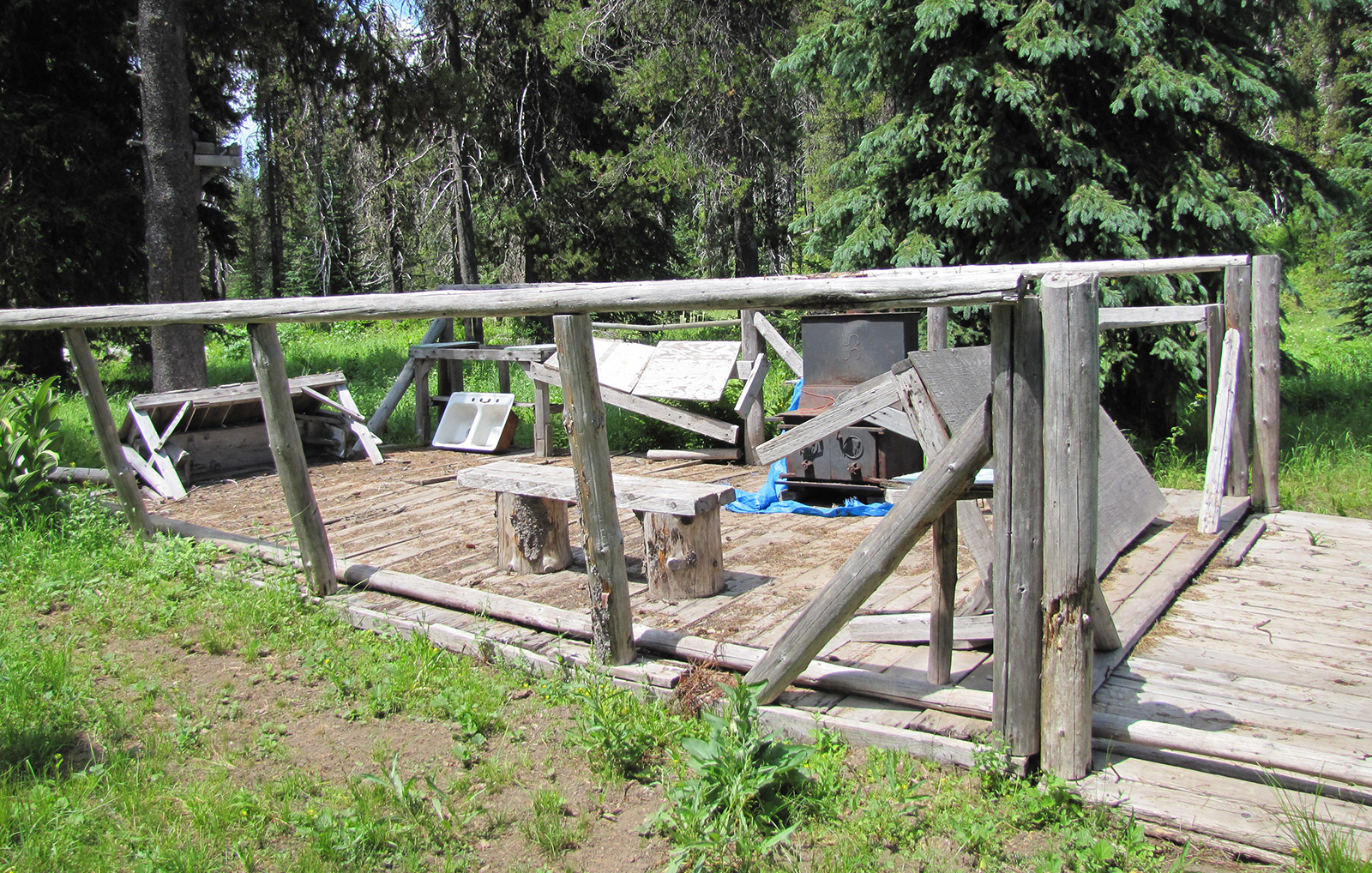
Outfitters with hunting areas on USFS lands are assigned specific areas for their camps. They are allowed to build semi-permanent structures and store items such as stoves and camp furnishings year-long. This was a deluxe camp in the 1970s, when Idaho’s Clearwater elk herd was booming. Today, the elk are gone, the camp is abandoned, and the stove and tent platform remain.
As I rode the backcountry, I also found where DIY hunters with stock had camped during hunting season. Many of these camps had hunting stoves of all makes and sizes either left at the campsite or stashed nearby back in the timber.
Back in the day, this was quite common. It was evident that these hunters packed in the stoves, but with heavy loads of game to pack out at the end of the hunt, the stove was often cached. hunting stoves like these would rust, but the bears couldn’t damage them and they were durable enough to be used year after year. As I observed these caches, I knew they were in violation of USFS rules. I wanted to stay on the “right side of the law”. Thus, my search for the ideal backcountry stove continued.
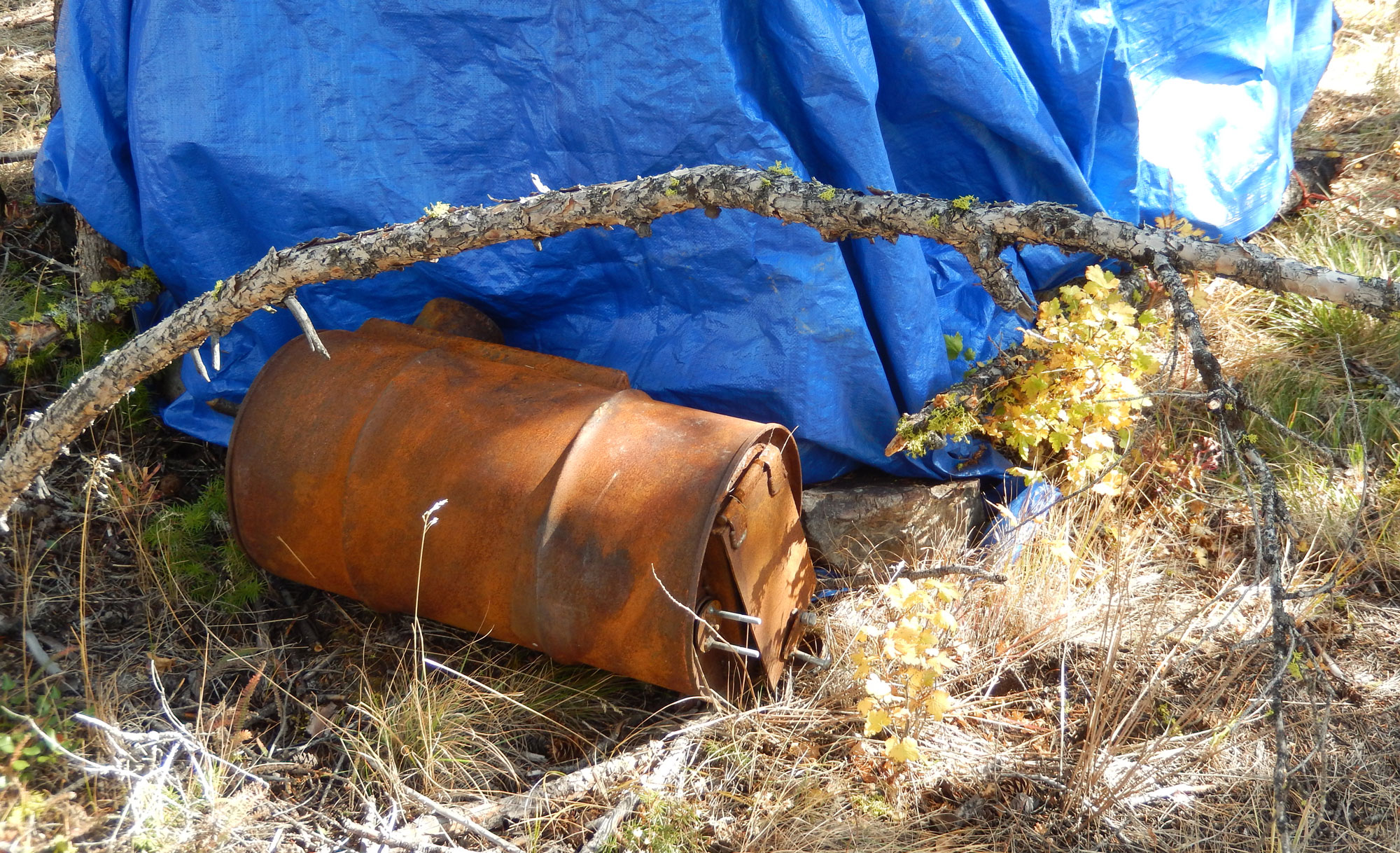
Although caches such as these are illegal on national forests and in wilderness areas, you can still find them. Backcountry rangers who find such caches will usually remove whatever they find and when possible, cite whomever is responsible.
My Search for the Perfect Backcountry Woodstove
There are a number of considerations for wood burning wall tent hunting stoves that are convenient to pack in the backcountry.
Size/shape:
I prefer a stove that is of such a size that it can be packed in a pannier or mantied and packed with either a basket hitch or barrel hitch. The larger the stove, the more difficult it is to pack.
Since I like to pack with a “system” of gear that all goes together, I prefer a stove that will fit into a pannier. The problem I encountered is that there are few hunting stoves on the market that will fit conveniently into a pannier. There are a lot of cylinder stoves on the market, but most are constructed of rolled steel and are heavy and awkward to pack.
As a result, I’ve had several styles of box stoves made of medium weight steel that will fit my panniers. They range from a 44-lb. 11”x11”x24” box stove to a 30-lb. folding box stove that measures 15”x22”x5” with nesting stove pipe when disassembled and packed.
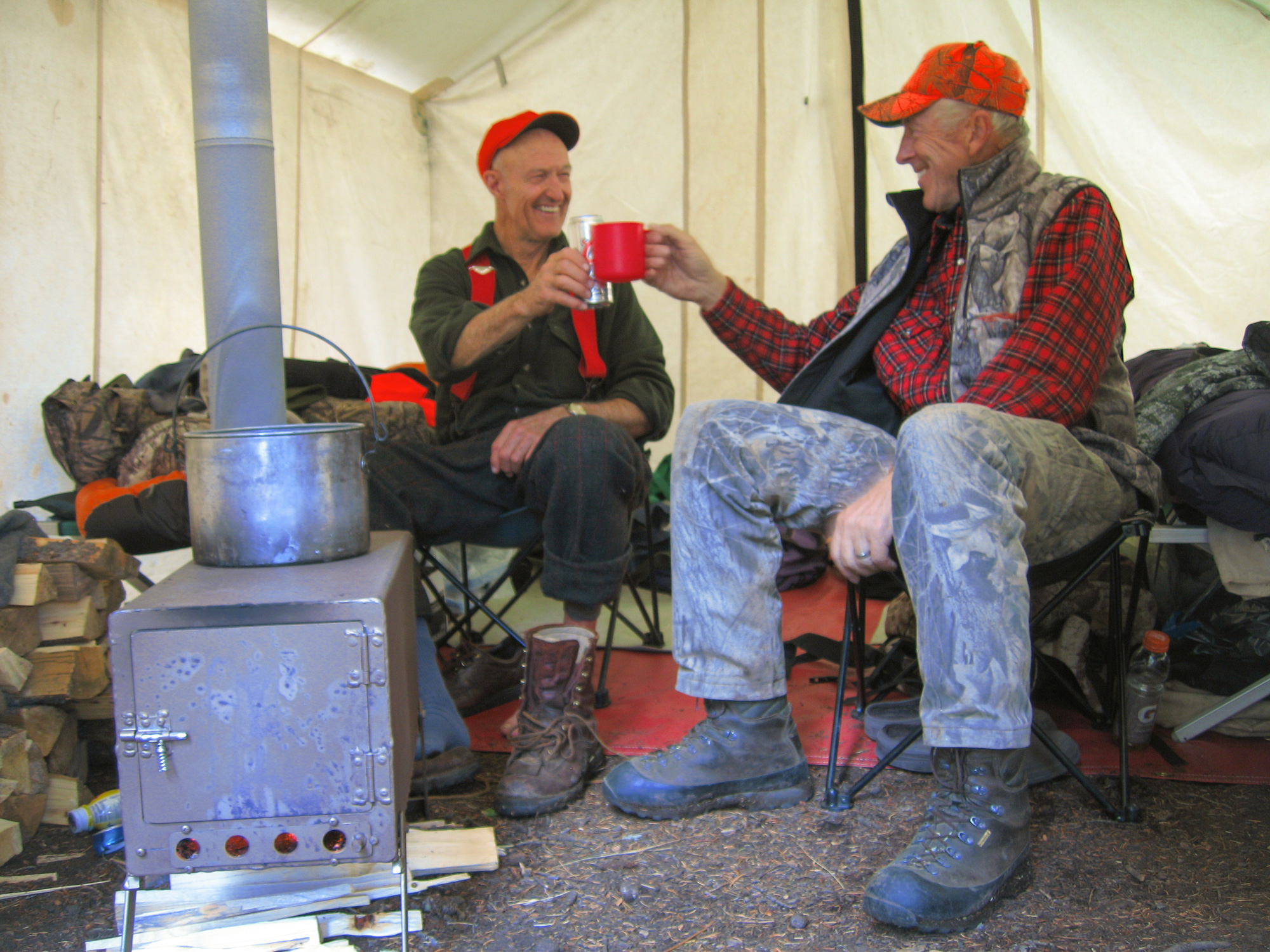
The stove that I prefer and use most often is a 44-lb. airtight steel “box” stove that measures 11"x11"x24" and fits nicely in a pannier. This stove will easily heat a 12x14 wall tent in any weather and a 14x16 wall tent in most weather.
Weight:
Weight is determined by materials, size, and design. I own and use a variety of hunting stoves, weighing from about 16 lbs. for the stove and nesting stove pipe (Four Dog Titanium Ultra-Lite 1DX) up to a 44-lb. (custom-built steel box stove).
The weight of the stove I choose is related to the style and size of the tent I’ll be using. I really like the titanium stove for use in an Arctic Oven tent. This combination will keep you warm in even the most severe winter weather. The 44-lb. steel box stove, as well as the 30-lb. folding box stove, work well in my wall tents, as noted. If you have a lot of stock, you may want to pack a heavier stove, but for my outfit, which usually includes about a dozen horses and mules, the 44-lb. stove is what I consider max for me.
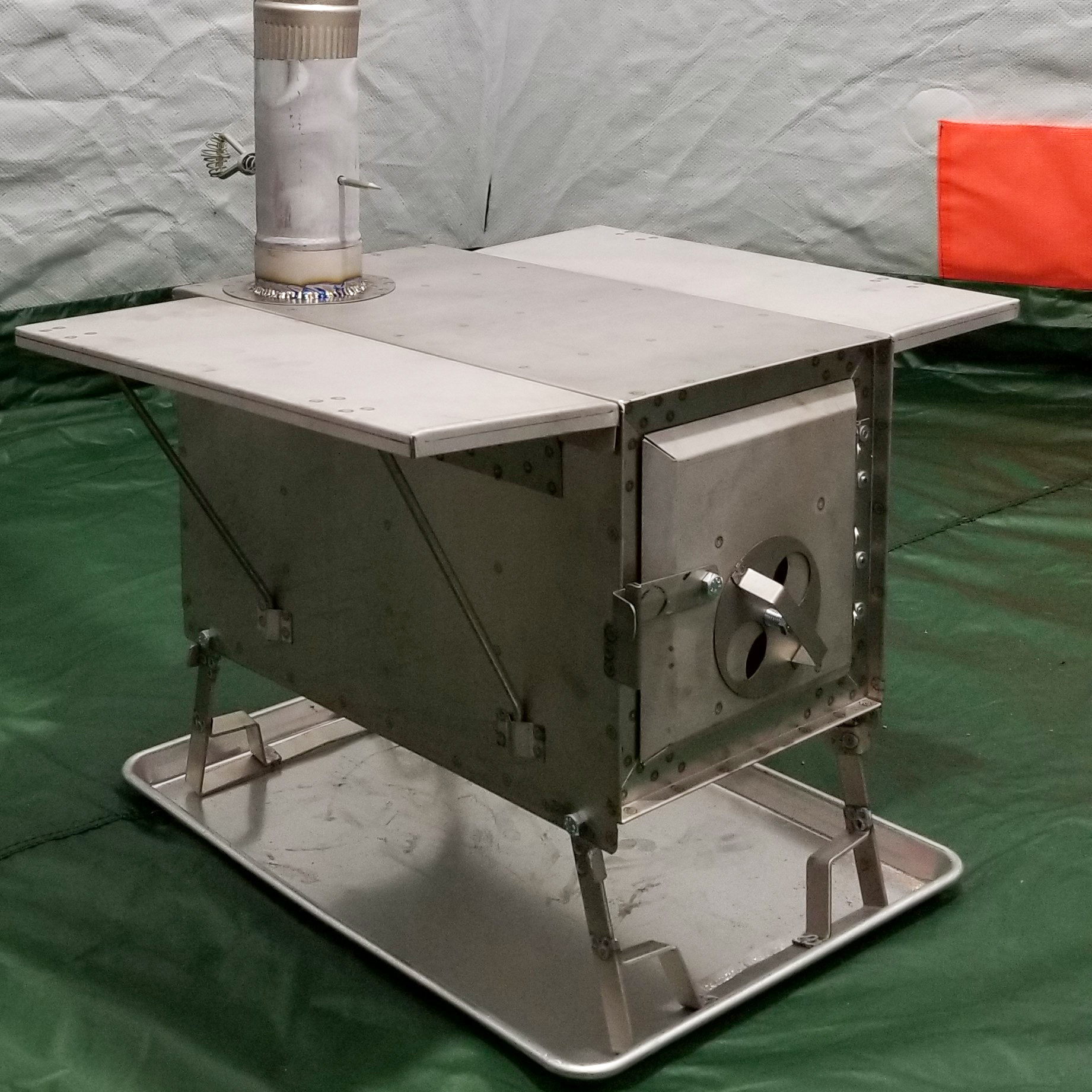
The Four Dog Titanium Ultra Lite 1DX is the most efficient and airtight ultralight stove I’ve used. It will keep an Arctic Oven tent warm even in the most severe winter temperatures.
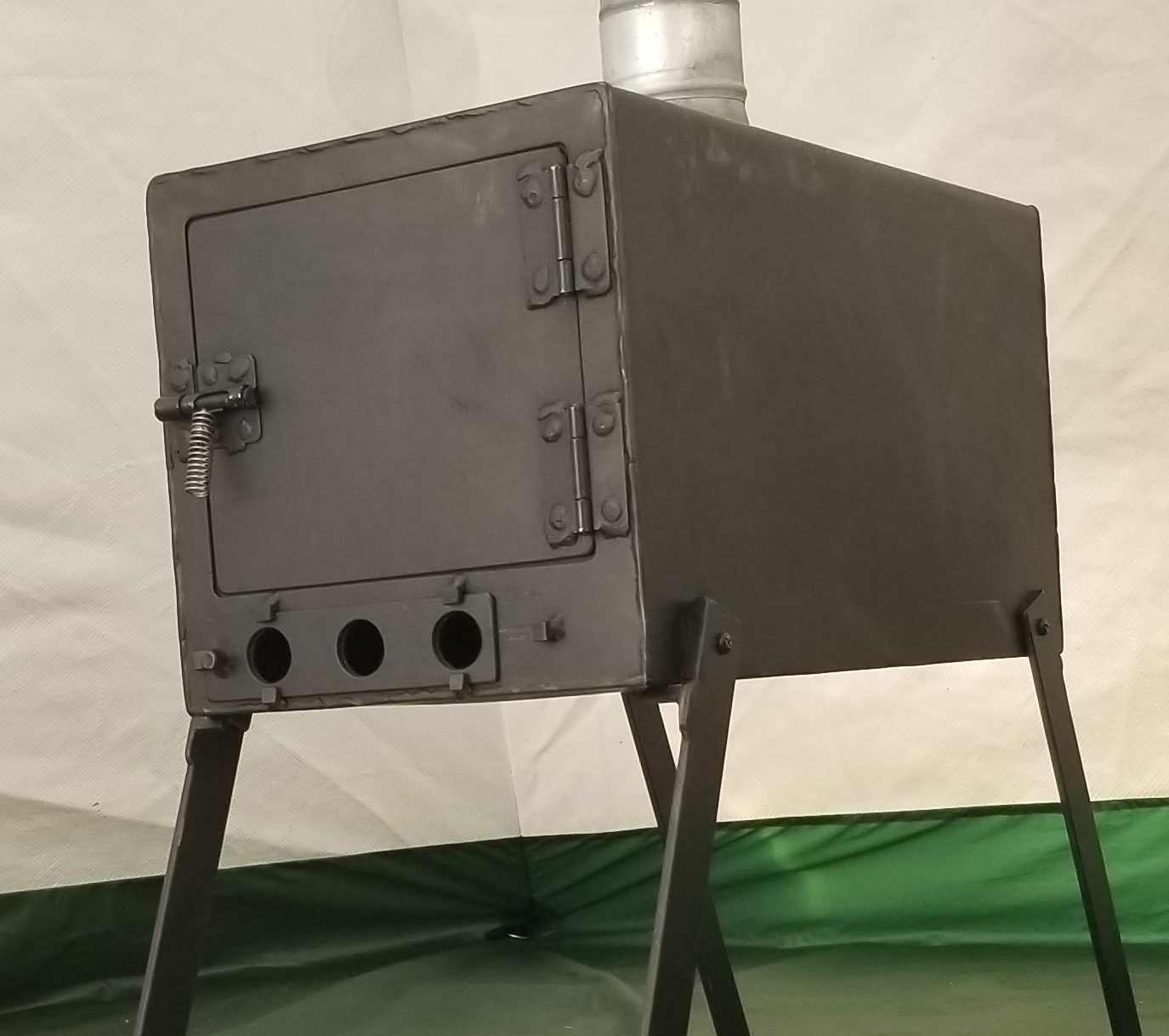
Sometimes you may need to have a stove made to your specifications in order to get what is just right for you. I had this airtight box stove made to my specifications at 9"x9"x18". The stove fits easily in a pannier, weighs 25 lbs. with nesting stove pipe, and heats a 10x12 wall tent.
Square feet to heat:
Generally, the larger the tent, the bigger the stove needed. However, tents with a “snow” flap or skirt around the bottom of the walls help a lot with reducing floor drafts if the flap is folded inward and then a tarp sized to fit the inside floor area is placed over the flaps.
I’ve found that a 12x14 tent is relatively easy to heat with a medium-size stove in most weather. My 44-lb. box stove has a 2.44 cubic feet firebox. The stove is designed to heat tents up to 14x16 (224 sq. ft.). My tent is 12x14 (168 sq. ft.), so the stove should keep our tent warm even at -20° or -30°F.
Size of your hunting party:
My hunting partner’s rule is “more than three in camp is a crowd”. Since a 12x14 tent will accommodate three hunters nicely, that’s what we use most often. A 10x12 tent works well for two hunters. My 12x14 weighs about 70 lbs. and the 10x12 about 50 lbs. Both can be top packed, so with a stove and pannier that weighs about 50 lbs., you still have room for some food or personal gear on one horse.
Stove construction:
As a general rule, but not always, hunting stoves constructed of lighter gauge steel aren’t as airtight as stoves made of heavier gauge steel. The heavier the steel, the more durable the stove and the less it will warp.
High-quality lighter-weight hunting stoves often have stays or braces welded in the top and the side walls. The more airtight the stove, the larger space it will heat, and the longer it will burn. The construction of the stove door and airflow mechanism are directly related to the airtightness of a woodstove. Collapsible stoves take up less space, are usually lighter than the typical box stove, and are much easier to pack, but are not as airtight as box or cylinder stoves.
Fuel:
Depending upon how airtight the stove is and the type of wood I’m burning, my stove will hold heat for about four to five hours. Western larch (or tamarack as it is often called) is the most desirable fuel in the Northern Rockies. It burns just a little longer than Douglas-fir (often called red fir). Both of these burn longer than lodgepole and ponderosa pine, which are fair options. White pine, spruce, subalpine fir, and cottonwood are relatively poor for firewood. Although my hunting partner feeds the fire in the night, I prefer to use a high-quality down sleeping bag and light the fire again in the morning.
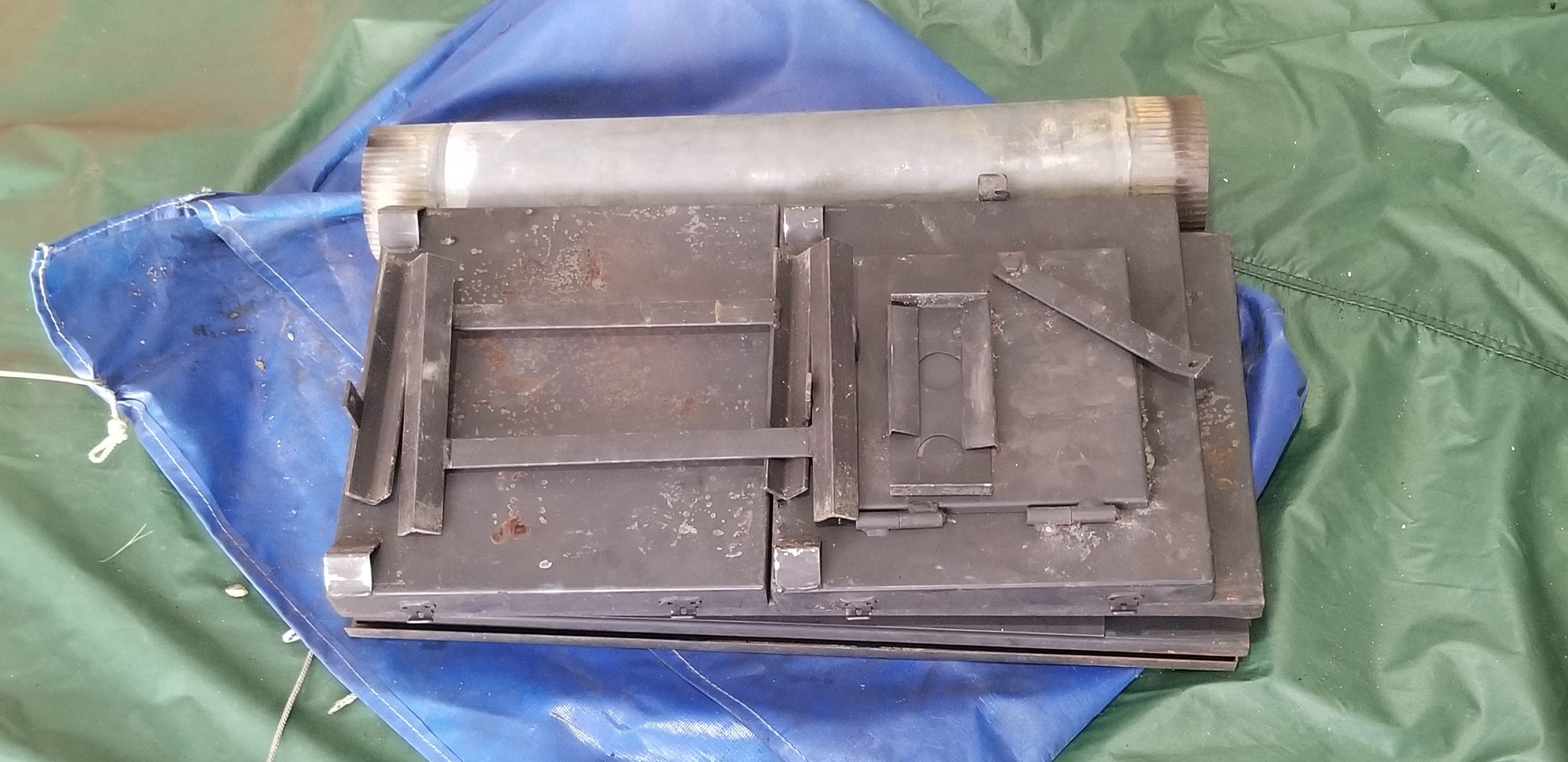
My collapsible stove weighs 30 lbs. and folds up into a 14x22x5 bag, including the collapsible stove pipe. It’s excellent for smaller wall tents when it’s not extremely cold. It’s about as airtight as a collapsible stove will get.
Wood Stove Accessories
Pipe damper: There are many accessories available, some more essential than others. In my view, the necessary stove accessories include a pipe damper and a spark arrestor. The pipe damper controls the flow of air up the stove pipe. This traps heat in the stovepipe, causes the wood to burn slower and increases the warmth of your tent.
Spark arrestor:
This will keep hot embers from falling on your tent and burning holes in the tent or the fly. The most common spark arrestors are simple screens on the top of the stove pipe. The screen will trap hot embers, but it can create a fire danger when a stove is choked down for the night. Creosote can build up on the screen and eventually catch fire.
The best spark arrestor I’ve found is a cylinder with holes in it that goes on the top of the stove pipe. This spark arrestor will burn the embers within the cylinder and not allow them to fall on your tent. These arrestors are especially useful for tents with nylon flies like the Arctic Oven.
Other:
Tents with the stove jack on the sidewall require a pipe elbow. Wood grates, hot water tanks, side shelves/warming trays, and chimney ovens are nice to have but add more weight and I don’t use them.
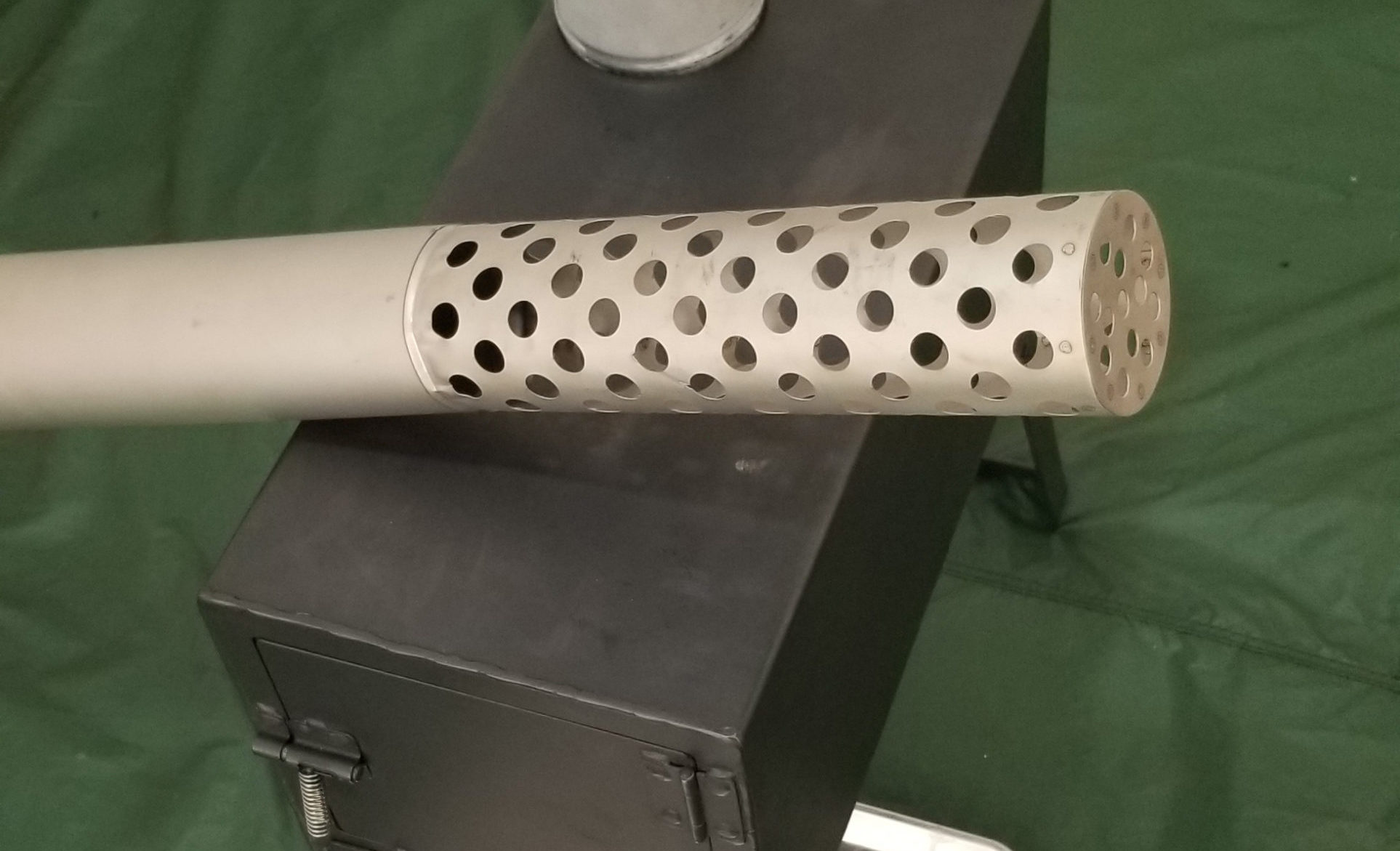
A stove pipe damper and spark arrestor are essential accessories. The spark arrestor illustrated is very efficient and will burn any hot embers that go up the stove pipe.
Stovepipes:
Common stove pipes come disassembled and nest together for packing, but they are a pain to pack out once they are assembled and corroded with creosote. Old stove pipes are the most common debris found in backcountry hunting campsites. Nesting stove pipes with sections that are incrementally smaller in diameter (so they all fit into the largest pipe section) are essential for a hassle-free pack. They can be cut to fit inside most box stoves.
Conclusion
When you’re planning a hunt, you must plan to be ready for anything. There are so many variables involved with what type of stove and tent you choose - elevation, time of year, size and style of tent you plan to use, the type of wood, how dry the wood is, how much air is feeding the fire, and the comfort needs of your hunting party. Some people like a tent and others don’t.
A high-quality winter-grade wall tent is essential for cold backcountry camps. Regardless of how big or efficient your stove may be, there’s no substitute for a high-quality wall tent with zipper doors and a snow skirt. A tent fly will add warmth as well.
My hunting partner is a big fan of the movie Lonesome Dove and names his mules after characters in the movie. When it comes to essential gear, as Woodrow Call said, “Better to have it and not need it than need it and not have it.” The more pack animals you have in your outfit, the more you can pack, and the larger and heavier the stove you can pack.
You can always make a small fire in a bigger stove, but you can’t make a bigger fire in a small stove. The key is to find the right stove for your outfit.




